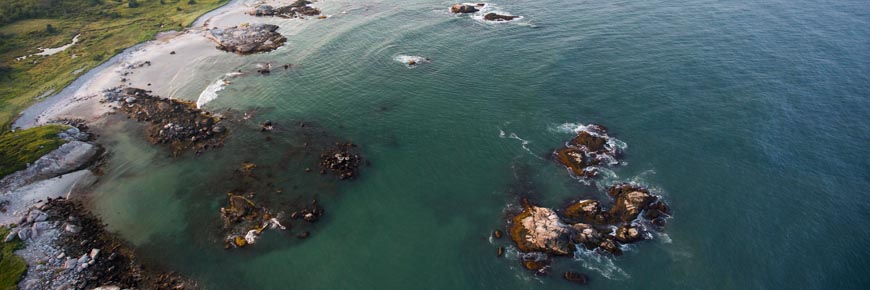
Coastal estuary restoration
Kejimkujik National Park and National Historic Site
Operation Green Crab at Kejimkujik National Park Seaside
The setting
Kejimkujik National Park – Seaside, on the Atlantic coast, protects a unique diversity of coastal habitats and communities in close proximity to each other. Two highly productive lagoon estuaries, at St. Catherine’s River beach and Little Port Joli beach, provide a rich diversity of invertebrates which feed resident and migratory birds and supports commercial and non-commercial marine species.
The situation

Parks Canada and partners began to realize in 2007 that the health of the coastal estuary ecosystem had declined rapidly over a very short period of time. Something was going on under the water, something that was affecting marine plants and animals, but most noticeably, the eel grass. Eelgrass coverage in the Port Joli estuary dropped dramatically: by 2010, only 2% of the baseline (1987) levels remained.
The predator

A hyper-abundant population of invasive European green crab had arrived.
Green crabs originally arrived in Nova Scotia through a northward migration from the Eastern United States. The species originated in Europe and North Africa and was introduced to local waters in the 1980s, likely due to travelling crabs hidden in ships’ ballast waters. The green crab is a hearty species, with a high tolerance for our cooler Atlantic waters.
The victims
Eelgrass performs important ecological services in nearshore waters and is often referred to as a ‘keystone species’ due to its ability to enhance biodiversity and productivity in dense underwater meadows. Eelgrass beds provide nursery habitat for the juvenile stages of fish and invertebrates, including many commercially important species in Atlantic Canada.
One species very clearly impacted by the damage to the Seaside eelgrass was the soft-shell clam, normally found in abundance in these waters. Young clams should outnumber their older counterparts by 10,000 to 1. At Kejimkujik Seaside, these numbers were reversed, with the older clams outnumbering the younger ones. Parks Canada staff also saw a decline in shore birds because the green crab was decimating the soft-shell clams that they feed on.
The showdown
Through local partnership, creativity and sheer volunteer power, Parks Canada is reversing the devastation and restoring the ecosystem.
Parks Canada has been working to curb the damage done by the green crabs by removing them from coastal waters. This work is done by hand, using a traditional rowboat and innovative traps designed by local fishers. Almost 2 million green crabs have been removed by Parks Canada staff and volunteers using these methods since 2010! The same dedicated team is re-planting eelgrass in areas where the crabs have been removed.
Parks Canada and its partners have continued to gain approximately 10% yearly in eelgrass coverage in Little Port Joli Estuary since 2010. Monitoring in 2015 shows a very impressive return to 34% eelgrass coverage and staff are starting to see Canada Geese and native marine invertebrates again in numbers that haven't been observed at the Seaside in a decade.
- Date modified :